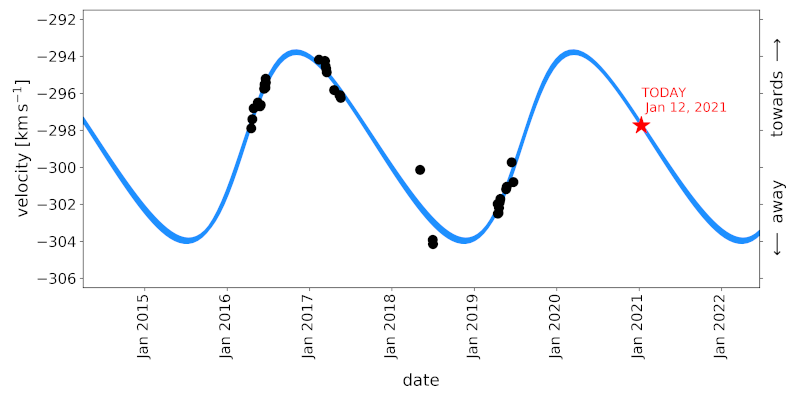Astronomers from the Sloan Digital Sky Survey have, for the first time, revealed details of how red giant stars in other galaxies feed their white dwarf companions.
The results, announced today at the 237th meeting of the American Astronomical Society, give researchers the first view of the orbital motions of any symbiotic binary star system outside the Milky Way.
“Measuring the orbits of these symbiotic star systems is an important step towards learning whether other galaxies create binary stars like those here in the Milky Way,” says Jasmin Washington of Steward Observatory at the University of Arizona, the lead author of the study.
Binary stars are common here in the Milky Way; in fact, more than half of all stars in our Galaxy come in pairs. There is no reason to think that they should not be just as common in other galaxies too — but astronomers have not yet been able to confirm this. Other galaxies are so far away, and their stars so faint, that observing the motion of one star orbiting another becomes nearly impossible.
However, if two stars in a binary pair are close enough together, the force of gravity can pull gas from one star into the other, which leaves a tell-tale signal that astronomers can observe. If the star consuming the matter is a white dwarf, this interaction is especially dramatic. Under normal circumstances, a white dwarf in a faraway galaxy would be too faint to see from Earth – but in these “symbiotic binary stars,” the gas becomes so dense and hot that it glows brightly enough to see.
Simply seeing this glowing beacon is not enough for astronomers to reveal the details of the symbiotic pair. The masses of both stars and how far apart they are determines how big of a meal the white dwarf is having. Measuring the masses and distance requires carefully monitoring the system for long enough – several years in most cases – to see the stars orbit and interact.
Hannah Lewis
“No one has ever done this in detail for symbiotic stars in other galaxies.”
“Very few symbiotic stars have ever been monitored long enough for astronomers to watch the full whirling dance,” says Hannah Lewis of the University of Virginia, Washington’s supervisor for the work. “And no one has ever done this in detail for symbiotic stars in other galaxies.”
To study symbiotic systems in nearby galaxies, Washington and her team took advantage of the repeat observations made by the Apache Point Observatory Galactic Evolution Explorer (APOGEE), one of the SDSS’s component surveys. The survey collects spectra – measurements of the amount of light given off at different wavelengths – for hundreds of thousands of stars, both in our Milky Way and nearby dwarf satellite galaxies.
Over the ten-year history of APOGEE observations, the survey has revisited nearly every one of those stars multiple times. These multiple visits allow subtle changes in the spectra to be detected.
Image credit: Washington et al.
The APOGEE spectra can reveal stellar motions. Just as the pitch of a train whistle sounds higher when the train approaches and lower when it recedes (a phenomenon called the Doppler effect), the frequency of light emitted by a star moving towards us shifts toward shorter wavelengths, and the frequency of light from a star moving away from us shifts toward longer wavelengths. By comparing the shift of a star’s spectrum to that expected from a star at rest, astronomers can determine whether the observed star is moving towards or away from us, and how fast. As one star in a symbiotic system orbits its companion, the back-and-forth shift of its spectrum indicates its back-and-forth motion relative to us. If astronomers watch long enough, they can determine the full orbit of the binary system, and from there they can calculate the relative mass of the two stars involved and how far apart they orbit.
One of the symbiotic star pairs, known as Draco C1, has an orbital period of about three years; the other, known as LIN 358, has an orbital period longer than two years. Both systems are located in Milky Way satellite galaxies, dwarf star systems that orbit around our larger home galaxy – Draco C1 is in the tiny, spherically shaped Draco dwarf galaxy and LIN 358 is in the somewhat larger, but still dwarf, Small Magellanic Cloud.
Washington, who at the time of the study was an undergraduate at the University of Virginia, worked with Lewis to perform the necessary calculations for two symbiotic star systems with many APOGEE observations spanning nearly complete orbits. Their findings make up the first full orbital measurements of any symbiotic star system outside our galaxy.
“Dwarf galaxies have very different internal environments and evolutionary histories from the Milky Way,” says Borja Anguiano, another astronomer at the University of Virginia who has been searching for white dwarf binaries in the APOGEE database, and who originally discovered that Draco C1 and LIN 358 had been serendipitously observed many times. “Soon we will have enough orbits mapped for binaries in other galaxies that we may begin to answer the question of whether different types of galaxies are more efficient at making binary stars.”
That question bears on other astrophysical problems. In some symbiotic stars, if the white dwarf gobbles up enough mass from its companion and exceeds a threshold, about one-and-a-half times the mass of the Sun, it explodes, destroying both stars. This gigantic explosion, one of the biggest in the Universe, is called a Type Ia supernova. These supernova blasts are so powerful that they can be seen all the way across the Universe, and they all have the same intrinsic brightness, making them ideal candidates for measuring distances to faraway galaxies.
Borja Anguiano
“Because we rely on Type Ia supernovae as distance measurements, it’s important that we understand exactly how they work.”
“Because we rely on Type Ia supernovae as distance measurements, it’s important that we understand exactly how they work, and what systems we should be looking for as possible supernovae progenitors,” Anguiano explains. “Being able to study the orbits of symbiotic stars in other galaxies will allow us to confirm whether the process of forming Type Ia supernovae is universal.”
While the Draco C1 and LIN 358 symbiotic star systems are unlikely to explode as supernovae, the prospect of studying other symbiotics outside of the Milky Way using APOGEE is exciting. And these two systems have already created their own surprises.
“Apart from showing the Doppler wobbles as a result of the orbital dance of the two stars, the APOGEE spectra also show that the transfer of mass between the stars in these two systems varies with time. This is a good clue that their orbits are likely highly elliptical rather than circular,” says Lewis.
Soon APOGEE will have many more orbits mapped for more binary stars in other galaxies. This work requires long term monitoring and many repeat observations of these rare stars, so it’s good news that SDSS will be continuing for at least another half decade. Through the fifth phase of the Sloan Digital Sky Survey (SDSS-V)’s Milky Way Mapper, monitoring of more symbiotic systems in other galaxies will be possible, and the question of how binary star systems form in different types of galaxies will be closer to being answered.
Images
Image #1
Image #2
A time sequence of the motions measured by the APOGEE data for Draco C1, which has been monitored repeatedly over the last 5 years. Black dots are the data, while the blue curve shows the model for the orbital motion of the red giant as it circles the white dwarf and moves towards and away from the observer.
Image credit: Washington et al.
Contacts
- Jasmin Washington, Steward Observatory, University of Arizona,
washingtonj@email.arizona.edu - Hannah Lewis, University of Virginia,
hlewis@virginia.edu - Borja Anguiano, University of Virginia,
ba7t@virginia.edu
, Twitter: @borja_anguiano - Karen Masters, SDSS Scientific Spokesperson, Haverford College
klmasters@haverford.edu, +1-610-795-6066
Twitter: @KarenLMasters / @SDSSurveys - Jordan Raddick, SDSS Public Information Officer, Johns Hopkins University, raddick@jhu.edu, +1-443-570-7105
Twitter: @raddick
About the Sloan Digital Sky Survey
Funding for the Sloan Digital Sky Survey IV has been provided by the Alfred P. Sloan Foundation, the U.S. Department of Energy Office of Science, and the Participating Institutions. SDSS acknowledges support and resources from the Center for High-Performance Computing at the University of Utah. The SDSS web site is www.sdss.org.
SDSS is managed by the Astrophysical Research Consortium for the Participating Institutions of the SDSS Collaboration including the Brazilian Participation Group, the Carnegie Institution for Science, Carnegie Mellon University, Center for Astrophysics | Harvard & Smithsonian (CfA), the Chilean Participation Group, the French Participation Group, Instituto de Astrofísica de Canarias, The Johns Hopkins University, Kavli Institute for the Physics and Mathematics of the Universe (IPMU) / University of Tokyo, the Korean Participation Group, Lawrence Berkeley National Laboratory, Leibniz Institut für Astrophysik Potsdam (AIP), Max-Planck-Institut für Astronomie (MPIA Heidelberg), Max-Planck-Institut für Astrophysik (MPA Garching), Max-Planck-Institut für Extraterrestrische Physik (MPE), National Astronomical Observatories of China, New Mexico State University, New York University, University of Notre Dame, Observatório Nacional / MCTI, The Ohio State University, Pennsylvania State University, Shanghai Astronomical Observatory, United Kingdom Participation Group, Universidad Nacional Autónoma de México, University of Arizona, University of Colorado Boulder, University of Oxford, University of Portsmouth, University of Utah, University of Virginia, University of Washington, University of Wisconsin, Vanderbilt University, and Yale University.





